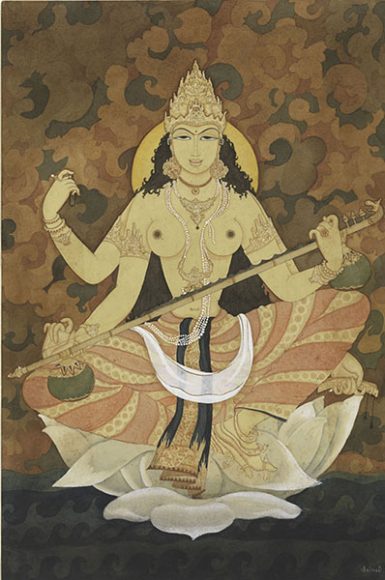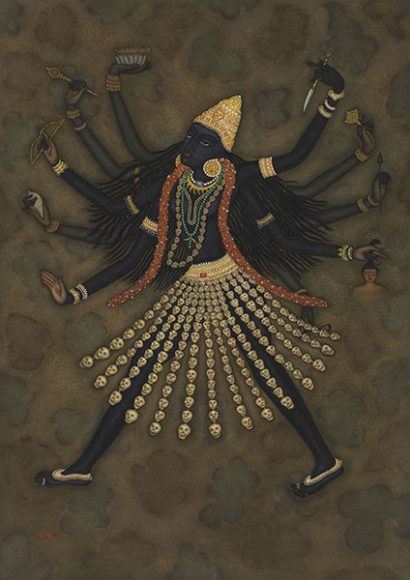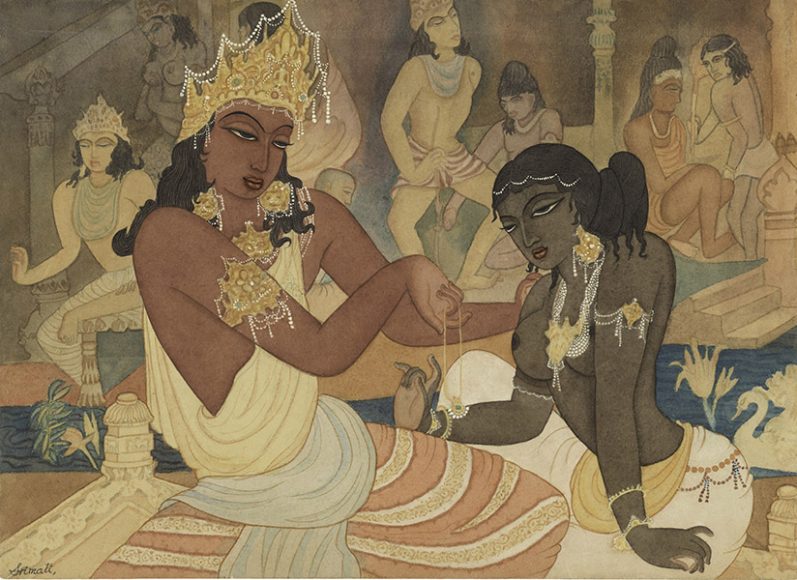In the quietude of The Metropolitan Museum of Arts’ South and Southeast Asia Galleries lies an exhibit for the garden of the soul.
“An Artist of Her Time: Y.G. Srimati and the Indian Style” (through June 5) is, in curator John Guy’s own words, “a modest show.” But it plumbs the big themes of nationalism and artistic interdependence in the work of a now little-known, New York-based artist who died 10 years ago.
Y.G. Srimati — the Y.G. was an honoric title, first bestowed on her grandfather, who was the royal astrologer to the maharaja of Mysore — helped bring classical Indian culture to the world, through not only richly textured watercolors but dance, song and instrumental music.
Born in 1926 in Mysore in southwestern India, Srimati grew up in coastal Chennai in a sophisticated family of Brahmins, the highest Indian caste. There her older brother, Y.G. Doraisami, mentored her in classical dance, singing, instrumental music and painting.
Yet while still a teenager, Srimati became caught up in the movement for Indian independence and equality, performing devotional songs in various Indian languages at rallies addressed by Mahatma Gandhi. (He was assassinated on Jan. 30, 1948, five months after India became an independent country.)
“These momentous events, and her personal encounter with Gandhi, were to strongly shape much of the orientation and agenda of Srimati the painter,” Guy writes in a lucid essay for Orientations magazine’s January/February issue. The Gandhi-like respect for rural life and the working man can be seen in “The Bullock Cart” (circa 1950), which allows the viewer to glimpse the driver’s family and, thus, connect them to his work.
Srimati not only looked to traditional texts for inspiration and themes; she also took to heart the advice set forth in the ancient text the Chitrashastra, which urged visual artists to take their cues from the performing arts.
“This makes her work particularly lyrical,” says Guy, the Florence and Herbert Irving curator of the arts of South and Southeast Asia in The Met’s Department of Asian Art. “It has a wonderful sense of line.”
Indeed, a work like “Shiva Gangadhara, ‘Bearer of the Ganga’” (1945) practically dances on the page with the god lunging forward, angling his feet as his many arms wind the river Ganges in his long, luxuriant locks, thus saving the earth from a flood.
Working with what Guy describes as “the finest materials available in her day” — Winsor & Newton paints on J.B. Green and J. Whatman art papers — Srimati would make painstaking underdrawings of such figures as Shiva before the painting process began.
“She would build up her watercolors as if they were oil paints,” says Guy, who had access to her estate and archives of diaries, exhibit catalogs, performance programs, press clippings and related ephemera in preparing The Met show.
Such technical complexity yields a sensuality that many might consider the hallmark of classical Indian art. In “Carudatta Presenting a Pearl Necklace to Vasantesena” (circa 1952), based on a third- or fourth-century play, a noble Brahmin, Carudatta — he of the heavy-lidded eyes and full lips — allows the necklace to drip from one upturned palm as the courtesan Vasantesena leans forward to receive it in a manner that emphasizes her ripe breasts.
Their arm bracelets, necklaces and sculpted drapery only serve to accent their exposed flesh, as does the backdrop of bathers, lotuses and swans.
Yet all is not mere sexiness. There is true love here, Guy says, a profundity of feeling that Srimati evokes.
In 1963, the artist moved to New York, which would remain her base for most of the rest of her life. She continued to paint and exhibit and increasingly perform. But she resisted the pull of Western and Modern art and the movements in abstraction and Pop that were taking hold. “And she was not a good self-promoter, so she sort of got forgotten,” Guy says.
Still, he titled the show “An Artist of Her Time.” In an age defined by the tension between nationalism and immigration, the woman who played a role in Indian sovereignty and bringing Indian culture to the world might be an artist of our time as well.
For more, visit metmuseum.org.







